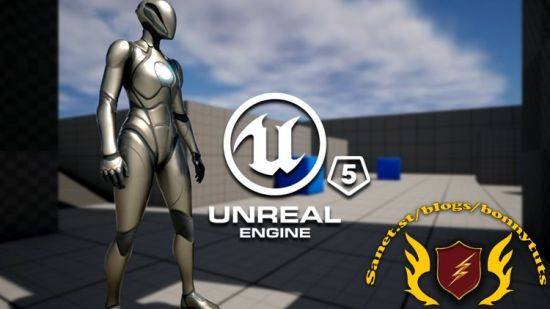
通过在虚幻5中构建原型来了解平台化游戏机制!欢迎来到我的虚幻5平台游戏机制课程。在本课程中,我们将从虚幻5提供的第三人称模板项目开始,了解该项目的各个组件,它们是如何工作的,以及我们如何在它们的基础上进行构建。在运动部分,我们将使用新的增强输入系统在事件图中创建事件驱动的输入机制,根据需要添加额外的输入。如果这是您第一次使用蓝图,不要担心,我们将讨论不同的节点和变量类型。您还将了解调试实践以及从测试用例中收集有用的数据。我们还将回顾动画蓝图,状态机是如何工作的;角色如何以及何时在不同的动画状态之间转换。此外,我们将使用新的尼亚加拉系统创建视觉效果,并使用事件图和动画来同步游戏效果。在跳跃部分,我们将回顾追踪角色状态并介绍几何系统。我们将回顾重力是如何在虚幻的物理常数中实现的,以及我们如何用它们来影响角色的跳跃。我们将定义我们角色的能力,设定角色能做什么和不能做什么的限制。我将向您展示如何将自定义事件绑定到跳转顶点,并使用它来改变重力比例。您将学习如何编写接受输入参数的函数,碰撞器如何工作,以及在游戏中碰撞如何触发事件。所有这些将帮助我们创造跳跃机制,感觉更自然,更直观,玩起来更有趣。在坠落部分,我们将使用PlayerStart对象让玩家重生,学习游戏模式和控制器。我们将实现各种机制,为玩家提供游戏中常见的帮助,但打破了物理定律;郊狼时间,跳跃缓冲,空气控制和空气制动。您将了解关于事件图中不同节点和变量类型的更多信息,以及动画如何触发事件。在冲刺部分,我们将导入一个新的角色和动画到虚幻中。我们将为我们的新角色创建一个新的动画蓝图和状态机,并将动画融合在一起。然后我们将为我们的新角色建立一个全新的平台机制;风度翩翩。我们将赋予dash自己的动画和特效,并学习diegetic UI。我为这门课程计划了更多的内容,并将在完成后添加更多的章节。Platforming Game Mechanics in Unreal 5
由Thomas Yanuziello创作
MP4 |视频:h264,1280×720 |时长:3小时54分钟 语言:英语+中英文字幕(云桥CG资源站 机译)
你会学到什么
良好的游戏机制带来更令人满意的玩家体验。
如何使用虚幻引擎5从零开始构建游戏原型?
了解常见的游戏机制是如何实现的,以及如何在自己的游戏中实现它们。
完成一个已发布的平台化游戏的案例研究,理解游戏开发者如何以及为什么实现平台化机制。
开发、测试和调整游戏机制,让你的游戏机制变得有趣。
要求
学生应该已经对虚幻引擎有了基本的了解。
不需要编程经验。一切都将在蓝图中完成。
Learn about platforming game mechanics by building a prototype in Unreal 5!
What you’ll learn
Good gameplay mechanics that lead to a more satisfying player experience.
How to use Unreal Engine 5 to build a prototype game from scratch.
Learn how common gameplay mechanics are implemented and how you can implement them in your own games.
Complete a case study of a published platforming game to understand how and why the platforming mechanics were implemented they were by the game developer.
Develop, test, and tweak game mechanics to make your game mechanics fun.
Requirements
Students should already have a basic understanding of the Unreal engine.
No programming experience necessary. Everything will be done in blueprints.
Description
Welcome to my course on platforming game mechanics in unreal 5.In this course, we’ll start with the Third Person Template project that is provided by Unreal 5, learn about the individual components of this project, how they work, and how we can build upon them.In the Locomotion section, we’ll use the new Enhanced Input System to create event-driven input mechanics in the Event Graph, adding extra inputs as needed. If this is your first time using blueprints, don’t worry, we’ll go over what the different nodes and variable types are. You’ll also learn about debugging practices and collecting useful data from test cases. We’ll also go over the Animation Blueprint, how State Machines work; how and when the character transitions between different animation states. Plus we’ll create visual effects using the new Niagara System and use both the event graph and animations to synchronize the effects with the gameplay.In the Jumping section, we’ll go over tracking character states and introduce the Geometry system. We’ll go over how gravity is implemented in Unreal, physics constants, and how we can use them to affect the character’s jump. We’ll define our character’s capabilities, setting limits to what the character can and can’t do. I’ll show you how to bind a custom event to the jump apex and use that to alter gravity scale. You’ll learn how to write functions which accept input parameters, how colliders work, and how events can be triggered by collisions in your game. All this will help us create jumping mechanics which feel more natural, intuitive, and fun to play.In the falling section, we’ll use the PlayerStart object to respawn the player, learning about Game Modes and Controllers. We’ll implement a variety of mechanics which provide player assistance that are common in games but break the laws of physics; Coyote Time, Jump Buffer, Air Control, and Air Brakes. You’ll learn more about different node and variable types in the event graph, and how animations can trigger events.In the dashing section, we’ll import a new character and animations into Unreal. We’ll create a new Animation Blueprint and State Machine for our new character, and blend animations together. Then we’ll build an entirely new platforming mechanic for our new character; dashing. We’ll give this dash its own animation and special effects, and also learn about diegetic UI.I have lots more content planned for this course, and will be adding more sections as they are completed.
1、登录后,打赏30元成为VIP会员,全站资源免费获取!
2、资源默认为百度网盘链接,请用浏览器打开输入提取码不要有多余空格,如无法获取 请联系微信 yunqiaonet 补发。
3、分卷压缩包资源 需全部下载后解压第一个压缩包即可,下载过程不要强制中断 建议用winrar解压或360解压缩软件解压!
4、云桥CG资源站所发布资源仅供用户自学自用,用户需以学习为目的,按需下载,严禁批量采集搬运共享资源等行为,望知悉!!!
5、云桥CG资源站,感谢您的赞赏与支持!平台所收取打赏费用仅作为平台服务器租赁及人员维护资金 费用不为素材本身费用,望理解知悉!













